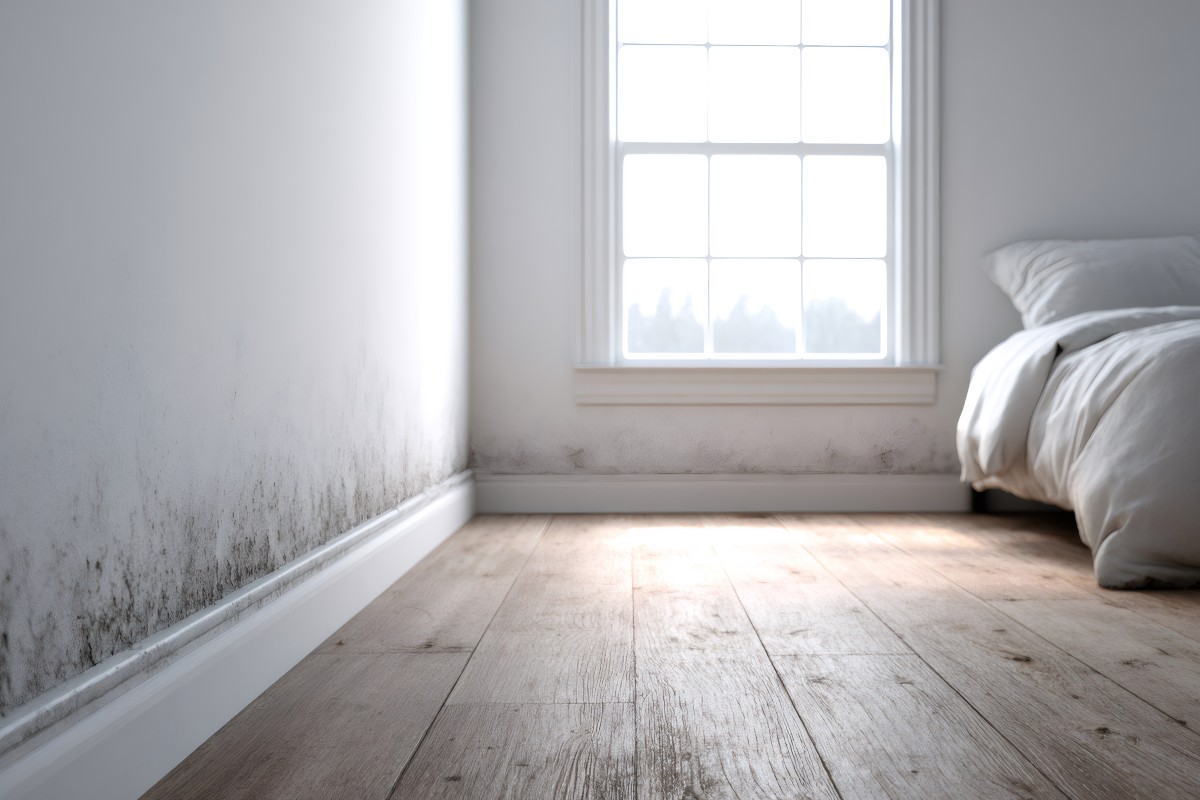
What Causes Mould on Walls in the Bedroom?
Unfortunately, we’ve all been there: you’re cleaning your room or looking around one evening and you spot it – mould. The uninvited guest that everybody dreads and seems to appear one day out of thin air. That dreaded tell-tale patch of black or greenish fuzz appears creeping in the corner like it's planning to take over your entire house.
So today we’re going to look at what actually causes mould on bedroom walls. Is it our fault or did we just get unlucky in this instance? Let’s find out together.
Mould 101: What is it?
If you didn’t already know, mould is a type of fungus that thrives in damp, humid conditions. It reproduces by releasing tiny spores into the air. Unbeknownst to most of us, these spores are constantly floating around in the air – you can’t ever fully escape them – but the problem only begins if they manage to find the right conditions to grow. Mould manages to take hold when moisture is present and the airflow in the room is poor. Enter: your bedroom wall.
Mould’s favourite spots:
- Behind furniture
- Window edges
- Cold corners
- Outside-facing walls
If you’ve been seeing it regularly, it’s a strong sign that something’s not quite right with the moisture levels in your room.
What causes bedroom wall mould?
Now that we know what mould is and understand it’s omnipresence, let’s have a look at some of the causes in a bit more detail. Scroll on to find out more.
1. Condensation
This is arguably the most common reason we find mould making itself known on our bedroom walls – even more so during the colder months. Condensation naturally happens when warm, moist air interacts with a cold surface (e.g. an exterior wall or single-glazed window). That moisture then ends up turning into water droplets. Over time, if that water isn’t dried off, it creates a lovely damp spot on your wall for mould to take root (1).
Where does the moisture in the air come from?
We’re all naturally producing it every day. Breathing, sweating, drying clothes indoors with the heating blasting, even boiling the kettle – all adds to the humidity levels in your home. It’s often the case that bedrooms don’t get as much ventilation as kitchens or bathrooms, which can effectively lead to a build-up of moisture over time.
1. Poor ventilation
Modern homes are now equipped with so much insulation that they don’t breathe like older properties used to. While that’s great for your heating bill and energy efficiency, it’s not so great for air flow. When there’s a lack of fresh air circulating, the moist air just sits around filling the room – and this creates the perfect conditions for mould to thrive.
If you rarely open your bedroom windows or you constantly have the trickle vents closed, the moist air doesn’t have anywhere to go. And so, it just sits there, gradually raising the humidity and making it more likely for condensation to form (2).
2. Cold walls or cold spots
Exterior walls can get really cold in winter, especially those that might not be insulated fully. When warm air from the room hits that cold wall, it creates condensation, leading to mould. It’s often even worse in the corners of rooms or behind furniture that’s fixed in place. These are those spots where the air doesn’t circulate well, and the surface generally stays cold for longer than other areas (3).
3. Leaks
Sometimes the problem isn’t from inside the house at all. An undiscovered leaking roof, clogged gutter, or cracked pipe could slowly be letting water into the walls, and that dampness becomes the perfect breeding ground for mould. If you’ve found a patch of mould that just won’t go away, and you’ve tried everything to eliminate it, it’s possible a hidden leak might be to blame (4).
4. Drying clothes indoors
During the winter most of us resort to a double win of drying clothes on the radiators and blasting the heating to warm things up. It’s understandable, not everyone has space for a tumble dryer or wants to pay to run it 24/7. It feels like a win-win but the downside in this instance is that drying clothes indoors can seriously increase humidity. The moisture has to go somewhere, and often it ends up on the walls. While it might feel counterproductive, open your windows if you’re drying clothes often in the winter, your house will thank you (5).
5. Blocked air bricks or vents
Some older houses might have air bricks or ventilation holes designed to let air flow through the building. If these get blocked up (or unknowingly covered over during renovations), the house loses some of its natural airflow allowing moisture to build up faster (6).
How to spot the early signs of mould on bedroom walls
Before your wall turns itself into a full-on science experiment, we’ve compiled are a few telltale signs mould is on its way:
- Black or green spots appearing on the paint or wallpaper, even if they seem tiny
- A musty, damp smell obvious in the room
- Wallpaper peeling or bubbling, corners or joins
- Damp patches or cold, walls that feel almost clammy
- Frequent condensation on windows in the morning
If you spot any of these, it's worth acting early, you’re not overreacting – it can be really difficult to get rid of mould once it’s set in (7).
What can you do about it?
Want to prevent mould in the bedroom? Here are some of the best ways to stop mould before it starts:
Improve ventilation
Open your bedroom windows every day, even if it’s only for a short period of time. This allows some of the moisture to escape. It’s important to continue to do this in winter, but if that’s too chilly for you, you could try using a dehumidifier to pull some of the moisture out of the air instead.
Make sure the trickle vents (little slots at the top of your window frames) are open. They're specifically designed to let some air circulate without losing too much heat.
Avoid drying clothes indoors (if you can)
If you can, dry clothes in a well-ventilated room, or use a heated airer with a cover and a dehumidifier nearby, it’ll help a lot. Failing this, keep your windows open when drying so all that moisture can escape. For more tips on drying washing indoors in winter, check out our dedicated blog post.
Move furniture away from walls
Try to leave a small gap between furniture (like wardrobes or beds) and external walls. That little bit of space lets air flow and helps to stop cold spots from developing.
Deal with leaks quickly
If you suspect a leak, resist that urge to ignore it and convince yourself it’ll be fine. Get in touch with a plumber, roofer, or whoever’s needed. Water damage spreads fast and will keep feeding mould, even if you clean it off regularly.
Keep the bedroom warm
It may sound obvious, but keeping the bedroom at a more consistent temperature (even a low background heat) stops the walls from getting cold enough for condensation to form.
Clean existing mould safely
If you’ve already got mould, don’t just paint over it – it’ll come back in no time. Use an anti-mould cleaner, wear gloves and a mask, and ventilate the room well while cleaning. If it’s a serious patch, you might need to consider getting a professional to come in and treat it.
Mould on bedroom walls: final thoughts
Mould on the walls is a common issue, but that doesn’t mean you should have to live with it. With a bit of knowledge and a few slight changes to how you use your space, you can keep things under control. The majority of mould problems in bedrooms is a result of moisture not being able to escape – so giving your home plenty of room to breathe is the key.
If in doubt, take a thorough look around your house during the colder months and figure out where condensation forms. Thinking about heating, ventilation, and habits can make a world of difference. And let’s face it, none of us want to wake up next to a mouldy wall.
Sources:

Gemma Henry - Content Lead
Gemma finds sleep fascinating and describes the discovery aspect of her role as eye-opening. Her keen eye for detail and dedication to thorough research ensures that Bensons customers get the informative sleep-based advice they're looking for.